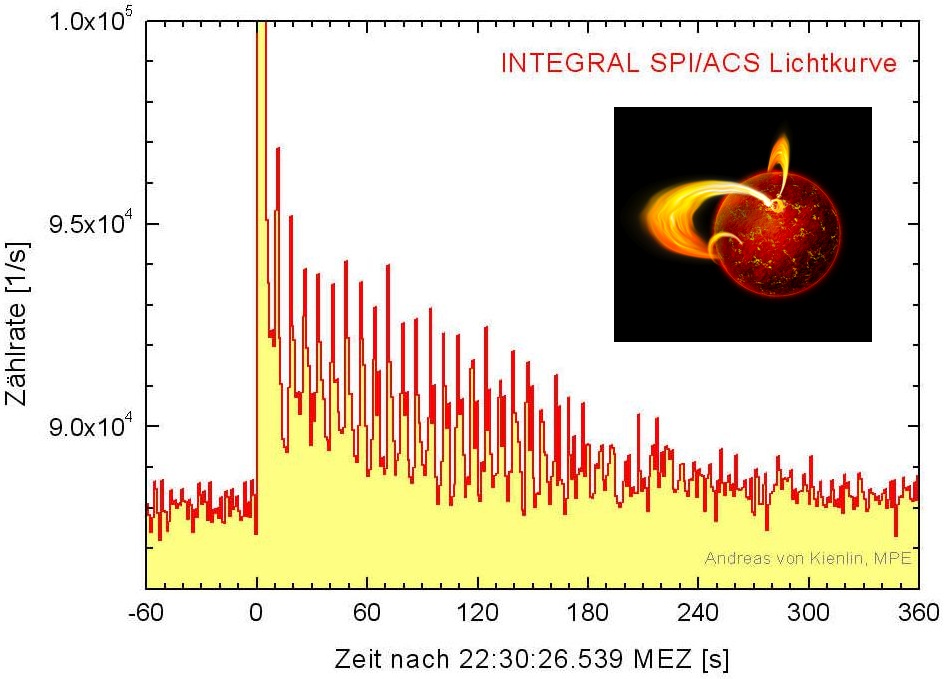Gamma-ray emission from magnetars and rotation-powered pulsars
Magnetars and strong-B-field pulsars harbour magnetic fields above the quantum electrodynamics (QED) limit. It is still not clear what processes in such extreme fields produce the non-thermal soft gamma-ray emission, nor do we understand the connection between the pulsar and magnetar population. In the recent years two Soft Gamma Repeaters (SGR) have been found with magnetic field strengths below the critical field of QED. A high-B-field radio-quiet rotation-powered pulsar, PSR B1846-0258, triggered by a timing glitch, behaved for 60 days like an SGR (outburst with short magnetar-like bursts), increasing simultaneously also its soft gamma-ray flux. A radio-emitting magnetar, AXP 1E1547-0548, created after a timing glitch a hard X-ray/soft gamma-ray pulse decaying over one year. The spectra of non-thermal pulsed and unpulsed persistent emissions from AXPs extends until at least 300 keV, but there are no measurements in the 300 keV – 10 MeV band to allow discrimination between the exotic theories aiming to explain these emissions. A recent study of all rotation-powered pulsars detected in the 20 – 200 keV band (only 15 in total due to the lack of sensitive observations at soft gamma-ray energies) shows that it comprises of young, energetic mainly radio-quiet or radio-dim pulsars, most of them not seen by Fermi. This appears to be a sample of pulsars peaking in luminosity at MeV energies, ideal targets for characterization with future more sensitive observations in this band, which would allow one to perform complete pulsar population studies.
Required instrument performances:
An instrument with a sensitivity 30 times better than COMPTEL will be able to study the outbursts and persistent soft gamma-ray emissions from magnetars, mentioned above, in great detail. Namely, the persistent pulsed emission from three AXPs is at 100 keV a factor of >2 stronger than that of the Vela PSR; the flux from AXP 1E1547-0548 reaches in outburst the level of PSR B1509- 58, already detected with COMPTEL. Non-thermal emission has been detected from millisecond pulsars below 30 keV and with Fermi/LAT above 100 MeV. Simple interpolation shows that their characteristics can be measured at MeV energies if in addition a timing accuracy < 50 μs can be reached. Polarization would also be unvaluable.

Lightcurve of the giant burst of SGR 1806-20 in December 27, 2004, as measured with the anti-coincidence shield of the INTEGRAL spectrometer. The inset shows an artist impression of a magnetar. Credits: A. von Kienlin for the SPI/ACS image, NASA/CXC/M.Weiss for the magnetar’s illustration
|
Required instrument performances:
An instrument with a sensitivity 30 times better than COMPTEL will be able to study the outbursts and persistent soft gamma-ray emissions from magnetars, mentioned above, in great detail. Namely, the persistent pulsed emission from three AXPs is at 100 keV a factor of >2 stronger than that of the Vela PSR; the flux from AXP 1E1547-0548 reaches in outburst the level of PSR B1509- 58, already detected with COMPTEL. Non-thermal emission has been detected from millisecond pulsars below 30 keV and with Fermi/LAT above 100 MeV. Simple interpolation shows that their characteristics can be measured at MeV energies if in addition a timing accuracy < 50 μs can be reached. Polarization would also be unvaluable.
| Performance parameter | Goal value | Remarks and notes |
| Field-of-view (FWHM, deg) | A few sr | To monitor any magnetar outburst in the Galaxy |
|
Angular resolution (FWHM, deg) |
0.1 – 0.2 | To avoid source confusion for measuring total emission in sky maps (unpulsed from magnetars, PWN around PSRs) |
|
Spectral resolution (ΔE/E @ Energy) |
< 10 % | |
|
Line sensitivity (@ Energy) (cm-2 s-1, 3σ, 1 Ms) |
||
|
Continuum sensitivity (in which energy band?) (cm-2 s-1 keV-1, ΔE=E, 3σ, 1 Ms) |
30 × COMPTEL |
To energies down to ~100 keV for PWNe, 0.1-10 MeV for magnetars and 0.1 – 30 MeV for PSRs |
| Timing performances | < 50 μs | |
|
Polarimetric capability (Minimum Polarization Fraction for a Crab source in 1 Ms) |
1 % |
|
| Real-time data? |
 AstroMeV
AstroMeV